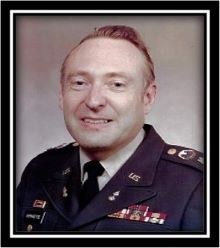Lieutenant Colonel Robert E. Vermette
 Lieutenant Colonel Robert E. Vermette graduated from the University of Rhode Island in
1958 and was commissioned as an Ordnance Officer but detailed as a guided missile officer which would later
prove invaluable to the country. His expertise in electronics and electrical engineering plus his early and
fortuitous assignment with Dr. Warner Von Braun at Redstone set the tone for a career’s accomplishments
worthy of induction into the Ordnance Hall of Fame.
Lieutenant Colonel Robert E. Vermette graduated from the University of Rhode Island in
1958 and was commissioned as an Ordnance Officer but detailed as a guided missile officer which would later
prove invaluable to the country. His expertise in electronics and electrical engineering plus his early and
fortuitous assignment with Dr. Warner Von Braun at Redstone set the tone for a career’s accomplishments
worthy of induction into the Ordnance Hall of Fame.
As a Guided Missile Officer, 2nd LT Vermette was assigned at Redstone Arsenal, Alabama He was assigned to the staff working with Dr. Rudolph on the developing and refining of the radio guidance system to determine the trajectory and distance performance of the Atlas missile system. His education as an Electrical Engineer and a Guided Missile Officer enabled him to make contributions to the team effort.
MAJ Vermette was tasked initially as the Embarkation Officer to move the organization from Ft. Carson, CO to Vietnam. The organization's task was to support military operations of the 3rd Marine Division in the hostile environment of Quan Tri operations. His familiarity and knowledge in the logistic field contributed to the rapid assessment and solution of numerous supply problems inherent in a combat environment and greatly enhanced the allied effectiveness against the enemies.
At this time, LTC Vermette was the US Army's only laser expert. Innovation and leadership as an Ordnance officer continued for him when assigned Electronic Countermeasures program at White Sands Missile Range (WSMR) in New Mexico. MG Patrick Powers commended him for his development of an integrated testing system for the AAH/ASH/Hellfire and Laser designators. The cost savings of that program were estimated to be $138.8M. He later became Chief of the Office of Missiles and Electronic Warfare (OMEW) and led the team developing and testing world-leading, laser guidance systems. LTC Vermette and his team's contribution was patriotic and humanitarian; they identified the electronic signatures of airplanes; this led to the Countermeasures Program to prevent civilian aircraft destruction by laser and electronic means still used in commercial air travel today.
Lieutenant Colonel Vermette retired on 31 October, 1995.